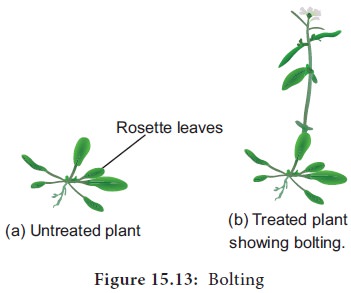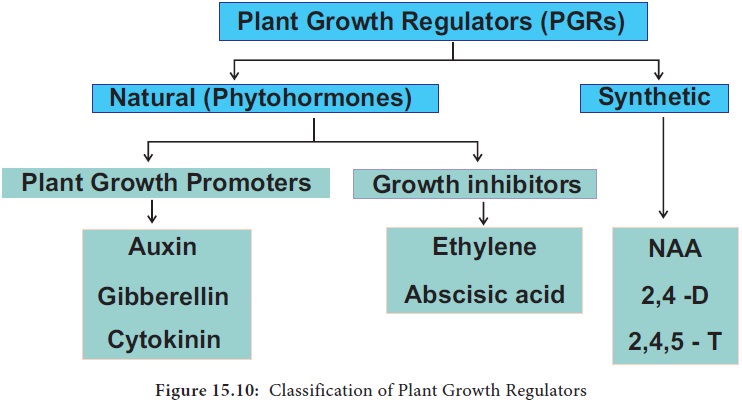Discovery, Occurrence, structure, Transport, Physiological Effects, Agricultural role - Gibberellins - Natural Plant Growth Regulators (PGRs) | 11th Botany : Chapter 15 : Plant Growth and Development
Chapter: 11th Botany : Chapter 15 : Plant Growth and Development
Gibberellins - Natural Plant Growth Regulators (PGRs)
Gibberellins
1. Discovery
The effect of gibberellins had been known in Japan since early 1800 where certain rice plants were found to suffer from ‘Bakanae’ or foolish seedling disease. This disease was found by Kurosawa (1926) to be caused by a fungus Gibberella fujikuroi. The active substance was separated from fungus and named as gibberellin by Yabuta (1935). These are more than 100 gibberellins reported from both fungi and higher plants. They are noted as GA1, GA2, GA3 and so on. GA3 is the first discovered gibberellin. In 1938, Yabuta and Sumiki isolated gibberellin in crystalline form. In1955, Brain et al., gave the name gibberellic acid. In 1961, Cross et al., established its structure.
2. Occurrence
The major
site of gibberellin production in plants is parts like embryo, roots and young
leaves near the tip. Immature seeds are rich in gibberellins.
3. Precursors
The
gibberellins are chemically related to terpenoids (natural rubber, carotenoids
and steroids) formed by 5 -C precursor, an Isoprenoid unit called Iso Pentenyl
Pyrophosphate (IPP) through a number of intermediates. The primary precursor is
acetate.
4. Chemical structure
All
gibberellins have gibbane ring structure.
5. Transport in plants
The
transport of gibberellins in plants is non-polar. Gibberellins are translocated
through phloem and also occur in xylem due to lateral movement between vascular
bundles.
6. Bioassay (Dwarf Pea assay)
Seeds of
dwarf pea are allowed to germinate till the formation of the coleoptile. GA
solution is applied to some seedlings. Others are kept under control. Epicotyle
length is measured and as such, GA stimulating epicotyle growth can be seen.
7. Physiological Effects
•
It produces extraordinary elongation of stem caused
by cell division and cell elongation.
•
Rosette plants (genetic dwarfism) plants exhibit
excessive internodal growth when they are treated with gibberellins. This
sudden elongation of stem followed by flowering is called bolting (Figure 15.13).

•
Gibberellin breaks dormancy in potato tubers.
•
Many biennials usually flower during second year of
their growth. For flowering to take place, these plants should be exposed to
cold season. Such plants could be made to flower without exposure to cold
season in the first year itself, when they are treated with gibberellins.
8.
Agricultural
role
•
Formation of seedless fruits without fertilization
is induced by gibberellins Example: Seedless tomato, apple and cucumber.
•
It promotes the formation of male flowers in
cuccurbitaceae. It helps in crop improvement.
•
Uniform bolting and increased uniform seed
production.
•
Improves number and size of fruits in grapes. It
increase yield.
•
Promotes elongation of inter-node in sugarcane
without decreasing sugar content.
•
Promotion of flowering in long day plants even
under short day conditions.
•
It stimulates the seed germination.

Related Topics